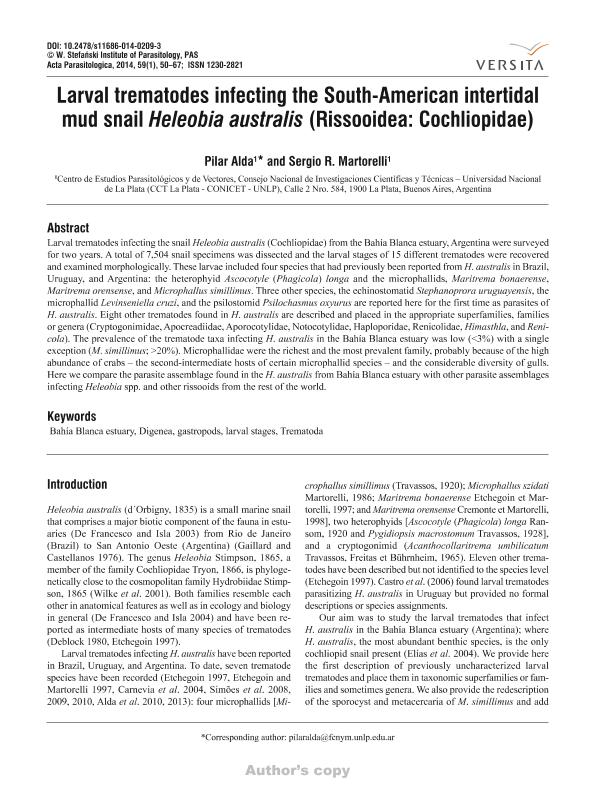Mostrar el registro sencillo del ítem
dc.contributor.author
Alda, Maria del Pilar

dc.contributor.author
Martorelli, Sergio Roberto

dc.date.available
2018-01-22T19:19:45Z
dc.date.issued
2014-02
dc.identifier.citation
Alda, Maria del Pilar; Martorelli, Sergio Roberto; Larval trematodes infecting the South-American intertidal mud snail Heleobia australis (Rissooidea: Cochliopidae); Versita; Acta Parasitologica; 59; 1; 2-2014; 50-67
dc.identifier.issn
1230-2821
dc.identifier.uri
http://hdl.handle.net/11336/34138
dc.description.abstract
Larval trematodes infecting the snail Heleobia australis (Cochliopidae) from the Bahía Blanca estuary, Argentina were surveyed for two years. A total of 7,504 snail specimens was dissected and the larval stages of 15 different trematodes were recovered and examined morphologically. These larvae included four species that had previously been reported from H. australis in Brazil, Uruguay, and Argentina: the heterophyid Ascocotyle (Phagicola) longa and the microphallids, Maritrema bonaerense, Maritrema orensense, and Microphallus simillimus. Three other species, the echinostomatid Stephanoprora uruguayensis, the microphallid Levinseniella cruzi, and the psilostomid Psilochasmus oxyurus are reported here for the first time as parasites of H. australis. Eight other trematodes found in H. australis are described and placed in the appropriate superfamilies, families or genera (Cryptogonimidae, Apocreadiidae, Aporocotylidae, Notocotylidae, Haploporidae, Renicolidae, Himasthla, and Renicola). The prevalence of the trematode taxa infecting H. australis in the Bahía Blanca estuary was low (<3%) with a single exception (M. simillimus; >20%). Microphallidae were the richest and the most prevalent family, probably because of the high abundance of crabs — the second-intermediate hosts of certain microphallid species — and the considerable diversity of gulls. Here we compare the parasite assemblage found in the H. australis from Bahía Blanca estuary with other parasite assemblages infecting Heleobia spp. and other rissooids from the rest of the world.
dc.format
application/pdf
dc.language.iso
eng
dc.publisher
Versita

dc.rights
info:eu-repo/semantics/openAccess
dc.rights.uri
https://creativecommons.org/licenses/by-nc-sa/2.5/ar/
dc.subject
Bahia Blanca Estuary
dc.subject
Digenea
dc.subject
Gastropods
dc.subject
Trematoda
dc.subject.classification
Otras Ciencias Biológicas

dc.subject.classification
Ciencias Biológicas

dc.subject.classification
CIENCIAS NATURALES Y EXACTAS

dc.title
Larval trematodes infecting the South-American intertidal mud snail Heleobia australis (Rissooidea: Cochliopidae)
dc.type
info:eu-repo/semantics/article
dc.type
info:ar-repo/semantics/artículo
dc.type
info:eu-repo/semantics/publishedVersion
dc.date.updated
2018-01-03T19:08:17Z
dc.journal.volume
59
dc.journal.number
1
dc.journal.pagination
50-67
dc.journal.pais
Polonia

dc.description.fil
Fil: Alda, Maria del Pilar. Consejo Nacional de Investigaciones Científicas y Técnicas. Centro Científico Tecnológico Conicet - La Plata. Centro de Estudios Parasitológicos y de Vectores. Universidad Nacional de La Plata. Facultad de Ciencias Naturales y Museo. Centro de Estudios Parasitológicos y de Vectores; Argentina
dc.description.fil
Fil: Martorelli, Sergio Roberto. Consejo Nacional de Investigaciones Científicas y Técnicas. Centro Científico Tecnológico Conicet - La Plata. Centro de Estudios Parasitológicos y de Vectores. Universidad Nacional de La Plata. Facultad de Ciencias Naturales y Museo. Centro de Estudios Parasitológicos y de Vectores; Argentina
dc.journal.title
Acta Parasitologica

dc.relation.alternativeid
info:eu-repo/semantics/altIdentifier/doi/http://dx.doi.org/10.2478/s11686-014-0209-3
dc.relation.alternativeid
info:eu-repo/semantics/altIdentifier/url/https://www.degruyter.com/view/j/ap.2014.59.issue-1/s11686-014-0209-3/s11686-014-0209-3.xml
Archivos asociados
